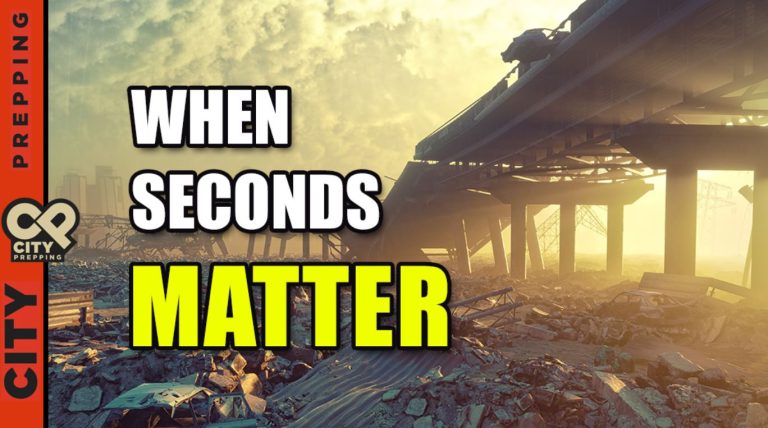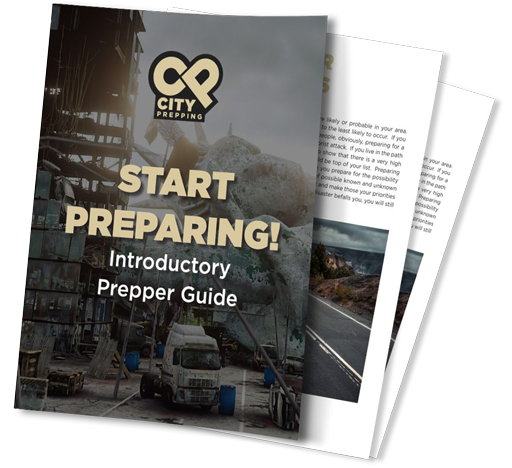- Seconds Before
- Seconds In the Disaster
- Seconds of Action
- Minutes After
- Hours After
 Every disaster has clear signals that proceed its arrival. A tsunami is preceded by the water receding far from shore. A tornado is preceded by a sudden barometric pressure drop and storm activity. Sometimes animals alert to the low-frequency waves before an earthquake. Even terrorist and lone-wolf attacks are often preceded by chatter, social media postings, threats, or other warning signs. When we look at historical events, we are often left wondering how our ancestors didn’t see this event or that tragedy coming. Do you think the citizens of Pompeii didn’t suspect Mount Vesuvius might one day blow?
The surprise factor of a disaster is part the shock of the event and part the few warning signs we pick up on preceding it. While we might have several warning signs before a tornado touches down on top of us, we know tornado season is coming, may have built a structure to retreat to, likely know the bad weather is coming, may have cracked a window in advance, may hear the warning sirens, and so forth. The surprise factor is really low. On the other hand, an earthquake may not have any significant number of warning signs before it occurs, yet we know that one will assuredly happen if we live in an earthquake-prone area. We may sense an inexplicable anxiousness inside us or observe others acting a little weird right before it strikes. Looking back from our safe vantage point of the future, how often do we say “I should have known from this,” or “my first clue should have been,” or “now I know to look for when this happens.” The fact is that few disasters come at us from out of the blue.
That’s where prepping comes into play. Proper prepping is preparing for the worst but hoping for the best. It’s about considering the most likely scenarios, understanding the warning signs, and alerting when those mental checkboxes get checked, or something appears out of the norm. Surviving a disaster is related to your understanding and interpretation of the seconds preceding a disaster. You have to train your brain to look for and interpret these warning signs and to intuitively recognize disruptions in the expected flows and patterns. Then, your brain will alert to behaviors and signs contrary to that normal baseline. Simple, right? Not exactly. It takes training.
To start, once or twice per day, take a pause. Look up from what you are doing and try to take in the whole landscape around you. What does the weather look like on the horizon? How are the people moving? At what pace is the world moving? What activities are they engaged in at the moment? Does anything or anyone seem out of place? What is the traffic like? Consider what you see, but also answer to yourself what you think it must be. If you can’t see the commuters because you are in your office building, think about what it must look like at that time on the road. Consider your own route home. Consider your means of egress from your current location. Is there an event along your route that day? You could ask yourself many questions about what you see and what you would expect to see while taking this mental training pause. Do this exercise at least once, randomly per day. It may take you a couple of minutes at first to feel satisfied that you are observing your surroundings, but after time you can quickly assess your surroundings in less than a minute. Eventually, you will be more astute at finding irregularities or incongruities in the world around you. This training will also help many of us who have become accustomed to staring at our phones all day. Retraining our minds to be aware of our surroundings is critical for anyone wanting to develop their situational awareness.
Those irregularities and incongruities may tip you off to larger, looming things. They may be the warning signs of the seconds before disaster strikes. Look for the warning signs, and when you note a warning sign, immediately move to the seconds in the disaster.
Seconds in the Disaster
Every disaster has clear signals that proceed its arrival. A tsunami is preceded by the water receding far from shore. A tornado is preceded by a sudden barometric pressure drop and storm activity. Sometimes animals alert to the low-frequency waves before an earthquake. Even terrorist and lone-wolf attacks are often preceded by chatter, social media postings, threats, or other warning signs. When we look at historical events, we are often left wondering how our ancestors didn’t see this event or that tragedy coming. Do you think the citizens of Pompeii didn’t suspect Mount Vesuvius might one day blow?
The surprise factor of a disaster is part the shock of the event and part the few warning signs we pick up on preceding it. While we might have several warning signs before a tornado touches down on top of us, we know tornado season is coming, may have built a structure to retreat to, likely know the bad weather is coming, may have cracked a window in advance, may hear the warning sirens, and so forth. The surprise factor is really low. On the other hand, an earthquake may not have any significant number of warning signs before it occurs, yet we know that one will assuredly happen if we live in an earthquake-prone area. We may sense an inexplicable anxiousness inside us or observe others acting a little weird right before it strikes. Looking back from our safe vantage point of the future, how often do we say “I should have known from this,” or “my first clue should have been,” or “now I know to look for when this happens.” The fact is that few disasters come at us from out of the blue.
That’s where prepping comes into play. Proper prepping is preparing for the worst but hoping for the best. It’s about considering the most likely scenarios, understanding the warning signs, and alerting when those mental checkboxes get checked, or something appears out of the norm. Surviving a disaster is related to your understanding and interpretation of the seconds preceding a disaster. You have to train your brain to look for and interpret these warning signs and to intuitively recognize disruptions in the expected flows and patterns. Then, your brain will alert to behaviors and signs contrary to that normal baseline. Simple, right? Not exactly. It takes training.
To start, once or twice per day, take a pause. Look up from what you are doing and try to take in the whole landscape around you. What does the weather look like on the horizon? How are the people moving? At what pace is the world moving? What activities are they engaged in at the moment? Does anything or anyone seem out of place? What is the traffic like? Consider what you see, but also answer to yourself what you think it must be. If you can’t see the commuters because you are in your office building, think about what it must look like at that time on the road. Consider your own route home. Consider your means of egress from your current location. Is there an event along your route that day? You could ask yourself many questions about what you see and what you would expect to see while taking this mental training pause. Do this exercise at least once, randomly per day. It may take you a couple of minutes at first to feel satisfied that you are observing your surroundings, but after time you can quickly assess your surroundings in less than a minute. Eventually, you will be more astute at finding irregularities or incongruities in the world around you. This training will also help many of us who have become accustomed to staring at our phones all day. Retraining our minds to be aware of our surroundings is critical for anyone wanting to develop their situational awareness.
Those irregularities and incongruities may tip you off to larger, looming things. They may be the warning signs of the seconds before disaster strikes. Look for the warning signs, and when you note a warning sign, immediately move to the seconds in the disaster.
Seconds in the Disaster
 When you recognize something out of the norm, you should immediately go to the action and assessment phase. I will address what to do when at home in a moment, but let’s assume you are away from home when you notice the warning signs of a disaster or the disaster occurs. First, grab your Everyday Carry Bag or Get Home Bag depending on what you have packed. Your EDC bag should be near you at all times. You may have left it in your vehicle or your office, so you need to make sure that either you can grab it and go or you must abandon it and go.
Second, know your escape routes. Assuming you can get to your escape routes and travel them, can you safely warn others. Tipping off just a few people along your escape route home can spread the word rapidly, but you need to make sure your own route home will not be impeded by warning others.
Third, you should immediately call from your mobile phone or smartphone whoever you need to get to your home location. You can text if you use text to speech or can do it while moving. If phone lines go out, it is sometimes still possible to get a text message out, as it can travel over WiFi signals. After any disaster, service is typically either overwhelmed or broken. Emergency communication walkie talkie and P2P apps like Bridgefy or Zello can send messages when other means may be overwhelmed or knocked out altogether.
As you make your retreat to your home base, make sure you are moving away from the epicenter of the disaster area. If the disaster is moving, like a fire or storm, it is possible your direct route home may not be feasible. It is possible your route may proceed in parallel with the disaster event. That’s not good. It is always better to move directly away from the epicenter. Be thinking of how big the epicenter of the event may be based upon your observations. How long around must you go to circumvent the disaster? While it may be possible that your home base is caught up in the disaster. If that is the case, you will want to move to your secondary location, bug out location, shelter area, or a safe friend or family member’s home. Getting home may require a lull in the storm and more significant planning.
Suppose you are at home, great. Stay there. Usually, when we are at home, and a short warning sign disaster strikes, we don’t know until we hear the noise or observe from our windows the chaos. Sometimes we hear sirens or the event’s loud noise or even suddenly register an eerie, quiet calm. Some of the immediate considerations when you are at home or away when disaster strikes are the same. What you consider is somewhat predicated by the disaster itself. What type of event is it? We will address that in the section ahead, but ask yourself, how bad it looks when the disaster registers with you? Is it localized? Are people leaving the disaster area that you can safely see from your windows or balcony? How thick of a crowd is making their exodus from the area? If it is a very dense crowd, you are close to the disaster’s epicenter, as crowds thin as they move further away from the area. If the crowds are thick, you need to diagnose to the best of your abilities the type and possible range of the disaster and whether staying at your home base is the best option.
If people face the disaster and are standing there observing, you are likely in the disaster’s shock and awe phase. That is the phase that can precede a much larger rollout of the disaster. If there are gunshots, it is not out of the ordinary to see people turned towards the noise. If there is an explosion, these people will face the blast’s shockwave directly. Their better course of action would have been to move in the opposite direction of the gunshots immediately. If you are caught in a blast or debris wave, by the way, move in the same direction the dust and the debris are traveling. It is easy to be disoriented, but just as you look for rising bubbles when underwater to find the surface, the blast cloud is similar.
Assuming you are safely in your home and have assessed the likely radius from the epicenter, intensity, and your proximity to the disaster, you should immediately launch into action.
Seconds of Action
When you recognize something out of the norm, you should immediately go to the action and assessment phase. I will address what to do when at home in a moment, but let’s assume you are away from home when you notice the warning signs of a disaster or the disaster occurs. First, grab your Everyday Carry Bag or Get Home Bag depending on what you have packed. Your EDC bag should be near you at all times. You may have left it in your vehicle or your office, so you need to make sure that either you can grab it and go or you must abandon it and go.
Second, know your escape routes. Assuming you can get to your escape routes and travel them, can you safely warn others. Tipping off just a few people along your escape route home can spread the word rapidly, but you need to make sure your own route home will not be impeded by warning others.
Third, you should immediately call from your mobile phone or smartphone whoever you need to get to your home location. You can text if you use text to speech or can do it while moving. If phone lines go out, it is sometimes still possible to get a text message out, as it can travel over WiFi signals. After any disaster, service is typically either overwhelmed or broken. Emergency communication walkie talkie and P2P apps like Bridgefy or Zello can send messages when other means may be overwhelmed or knocked out altogether.
As you make your retreat to your home base, make sure you are moving away from the epicenter of the disaster area. If the disaster is moving, like a fire or storm, it is possible your direct route home may not be feasible. It is possible your route may proceed in parallel with the disaster event. That’s not good. It is always better to move directly away from the epicenter. Be thinking of how big the epicenter of the event may be based upon your observations. How long around must you go to circumvent the disaster? While it may be possible that your home base is caught up in the disaster. If that is the case, you will want to move to your secondary location, bug out location, shelter area, or a safe friend or family member’s home. Getting home may require a lull in the storm and more significant planning.
Suppose you are at home, great. Stay there. Usually, when we are at home, and a short warning sign disaster strikes, we don’t know until we hear the noise or observe from our windows the chaos. Sometimes we hear sirens or the event’s loud noise or even suddenly register an eerie, quiet calm. Some of the immediate considerations when you are at home or away when disaster strikes are the same. What you consider is somewhat predicated by the disaster itself. What type of event is it? We will address that in the section ahead, but ask yourself, how bad it looks when the disaster registers with you? Is it localized? Are people leaving the disaster area that you can safely see from your windows or balcony? How thick of a crowd is making their exodus from the area? If it is a very dense crowd, you are close to the disaster’s epicenter, as crowds thin as they move further away from the area. If the crowds are thick, you need to diagnose to the best of your abilities the type and possible range of the disaster and whether staying at your home base is the best option.
If people face the disaster and are standing there observing, you are likely in the disaster’s shock and awe phase. That is the phase that can precede a much larger rollout of the disaster. If there are gunshots, it is not out of the ordinary to see people turned towards the noise. If there is an explosion, these people will face the blast’s shockwave directly. Their better course of action would have been to move in the opposite direction of the gunshots immediately. If you are caught in a blast or debris wave, by the way, move in the same direction the dust and the debris are traveling. It is easy to be disoriented, but just as you look for rising bubbles when underwater to find the surface, the blast cloud is similar.
Assuming you are safely in your home and have assessed the likely radius from the epicenter, intensity, and your proximity to the disaster, you should immediately launch into action.
Seconds of Action
 After your assessment, it is essential not to be a stunned observer. You have to launch into action. Here are the most common disasters and what your best course of action is. There are too many disasters to go into all of them, but this quick list should give you a general guideline to follow in most situations.
Earthquakes. I live in southern California, so these are a little more common out here. Because fracking practices can flood long-dormant and ancient fault lines, earthquakes are more frequent in areas where they haven’t been since prehistoric times. In the seconds of an earthquake, assess how close you are to a door to get safely out to the street. If you are in the interior of your home, take shelter between large pieces of heavy furniture. Even laying down beside a sofa or couch can afford you a triangle of protection if a heavy beam should collapse upon you.
Fire. At your first signs of fire (alarms, smoke, or flames), stay low and follow your escape route out of the building. If it is a small fire, like a kitchen fire, you may opt to use your fire extinguisher while also alerting others. If a fire occurs, evacuating the premises is typically your best option. Don’t place any phone calls or attempt to grab valuables that aren’t in arm’s reach already.
Tornado. Crack a window to avoid pressure explosions, and get to a basement, storm cellar, shelter, or the interior most room of your house. Lying down in the bathtub with a mattress over you should be a last resort, but it can be done. Stay away from windows, doors, and exterior walls. If you are outside and cannot get to shelter, lie flat in a ditch or other low location.
Explosion or shooting. During a blast, take shelter under a desk or in a low place along a center structural wall. Observe the movement away from the shooting or blast area and get to safety by fleeing or hunker down in a secure and hidden spot until first responders arrive. Do not use elevators. Above all else, keep as calm as possible. Don’t accept any speculative information or finger-pointing as truth. Some of these incidents take a long time to unravel. Focus on information pertaining to your immediate safety. Be vigilant and get away from the area unless you are needed to help others at the incident scene.
Hurricane. Monitor local news and weather alerts. Have a hurricane plan and supplies in place. Be prepared to evacuate. Before leaving your home, make sure to shut off utilities, propane, or natural gas.
Floods. In the event of floods, when you are also trapped in your house, you need to move to the highest spot in your home. If floodwaters are incredibly high, you will need to be able to access the top of your roof. If you have some forewarning, you may be advised to evacuate your area. In that situation, seek higher ground immediately.
Many more disasters can strike, but you should tell that there are some common characteristics from these alone. First, there are the information gathering seconds. Here you will need to assess, as I mentioned earlier, how immediate is the threat you are facing? Are you in the epicenter? Is the danger growing, contained, or complete? Do you have a pre-programmed plan in place for this situation? Are you at home or out? If out, do you have your everyday carry bag? These questions need to be answered in seconds because your survival depends on your ability to spring into action. Start moving along your escape route if out, or start your lockdown procedures if at home.
Minutes After
After your assessment, it is essential not to be a stunned observer. You have to launch into action. Here are the most common disasters and what your best course of action is. There are too many disasters to go into all of them, but this quick list should give you a general guideline to follow in most situations.
Earthquakes. I live in southern California, so these are a little more common out here. Because fracking practices can flood long-dormant and ancient fault lines, earthquakes are more frequent in areas where they haven’t been since prehistoric times. In the seconds of an earthquake, assess how close you are to a door to get safely out to the street. If you are in the interior of your home, take shelter between large pieces of heavy furniture. Even laying down beside a sofa or couch can afford you a triangle of protection if a heavy beam should collapse upon you.
Fire. At your first signs of fire (alarms, smoke, or flames), stay low and follow your escape route out of the building. If it is a small fire, like a kitchen fire, you may opt to use your fire extinguisher while also alerting others. If a fire occurs, evacuating the premises is typically your best option. Don’t place any phone calls or attempt to grab valuables that aren’t in arm’s reach already.
Tornado. Crack a window to avoid pressure explosions, and get to a basement, storm cellar, shelter, or the interior most room of your house. Lying down in the bathtub with a mattress over you should be a last resort, but it can be done. Stay away from windows, doors, and exterior walls. If you are outside and cannot get to shelter, lie flat in a ditch or other low location.
Explosion or shooting. During a blast, take shelter under a desk or in a low place along a center structural wall. Observe the movement away from the shooting or blast area and get to safety by fleeing or hunker down in a secure and hidden spot until first responders arrive. Do not use elevators. Above all else, keep as calm as possible. Don’t accept any speculative information or finger-pointing as truth. Some of these incidents take a long time to unravel. Focus on information pertaining to your immediate safety. Be vigilant and get away from the area unless you are needed to help others at the incident scene.
Hurricane. Monitor local news and weather alerts. Have a hurricane plan and supplies in place. Be prepared to evacuate. Before leaving your home, make sure to shut off utilities, propane, or natural gas.
Floods. In the event of floods, when you are also trapped in your house, you need to move to the highest spot in your home. If floodwaters are incredibly high, you will need to be able to access the top of your roof. If you have some forewarning, you may be advised to evacuate your area. In that situation, seek higher ground immediately.
Many more disasters can strike, but you should tell that there are some common characteristics from these alone. First, there are the information gathering seconds. Here you will need to assess, as I mentioned earlier, how immediate is the threat you are facing? Are you in the epicenter? Is the danger growing, contained, or complete? Do you have a pre-programmed plan in place for this situation? Are you at home or out? If out, do you have your everyday carry bag? These questions need to be answered in seconds because your survival depends on your ability to spring into action. Start moving along your escape route if out, or start your lockdown procedures if at home.
Minutes After
 In the minutes after disaster strikes, you should either be moving away from the disaster with the eventual intent of getting to safety, or you should be starting your lockdown and communication procedures. Lockdown is just as it sounds; you make sure all entries into your premises are secure. Draw shades and pull curtains. Your house or apartment should give the appearance of being occupied but not the certainty of it.
In the minutes after a major disaster, be prepared to turn off the main power, gas, and water leading to the house. It may not be necessary, but even more, significant damage could occur if pipes are broken or damaged. If you smell gas, evacuate immediately. Inspect your building for damage. Using a flashlight, check for gas and water leaks, broken electrical wiring, or sewage lines. If there is damage, turn the utility off at the source. If your systems appear fine, turn your attention to water. Immediately fill any bathtub you have deploying something like a WaterBOB if you have one. While the need for water may seem to not be too high on your list, addressing it in the minutes immediately after the disaster will ensure that your drinking water is not tainted and will keep you from having to rely solely on your stored water.
In the minutes immediately after the disaster, you need to communicate with the people in your household. Non-cellular connected apps or two-way radios are useful for this purpose if cellular systems are down. Those still outside of the domicile should either be trying to get to the domicile or the previously discussed bug out location or bug out waypoint.
If it is unsafe to stay in your home, if you smell gas or smoke, see fire, are told to evacuate, or genuinely fear for your safety where you are, leave immediately. Wear sturdy shoes and weather-appropriate clothing. Take your emergency bug out bag. Use municipal evacuation routes if possible, or move along your pre-planned and agreed-upon route. If you have communicated and planned well with your family, they can meet with you at prescribed waypoints along the way. You can consult my video How Safe Are Your Bug Out Escape Routes? 7 Ways To Get There Safely for a more extensive explanation on everything from bug out modes of transportation to picking routes. I’ll put a link to that video at the end of this one. It will help you to understand how to get there safely.
Hours After
In the minutes after disaster strikes, you should either be moving away from the disaster with the eventual intent of getting to safety, or you should be starting your lockdown and communication procedures. Lockdown is just as it sounds; you make sure all entries into your premises are secure. Draw shades and pull curtains. Your house or apartment should give the appearance of being occupied but not the certainty of it.
In the minutes after a major disaster, be prepared to turn off the main power, gas, and water leading to the house. It may not be necessary, but even more, significant damage could occur if pipes are broken or damaged. If you smell gas, evacuate immediately. Inspect your building for damage. Using a flashlight, check for gas and water leaks, broken electrical wiring, or sewage lines. If there is damage, turn the utility off at the source. If your systems appear fine, turn your attention to water. Immediately fill any bathtub you have deploying something like a WaterBOB if you have one. While the need for water may seem to not be too high on your list, addressing it in the minutes immediately after the disaster will ensure that your drinking water is not tainted and will keep you from having to rely solely on your stored water.
In the minutes immediately after the disaster, you need to communicate with the people in your household. Non-cellular connected apps or two-way radios are useful for this purpose if cellular systems are down. Those still outside of the domicile should either be trying to get to the domicile or the previously discussed bug out location or bug out waypoint.
If it is unsafe to stay in your home, if you smell gas or smoke, see fire, are told to evacuate, or genuinely fear for your safety where you are, leave immediately. Wear sturdy shoes and weather-appropriate clothing. Take your emergency bug out bag. Use municipal evacuation routes if possible, or move along your pre-planned and agreed-upon route. If you have communicated and planned well with your family, they can meet with you at prescribed waypoints along the way. You can consult my video How Safe Are Your Bug Out Escape Routes? 7 Ways To Get There Safely for a more extensive explanation on everything from bug out modes of transportation to picking routes. I’ll put a link to that video at the end of this one. It will help you to understand how to get there safely.
Hours After
 When a significant disaster strikes, getting through the first few hours may be exhausting and seem to draw on for days. Time slows down because our bodies and minds are hyper-alert, and the decisions we need to make often require us to think fast and move faster. This time compression is expected. In the hours after a major disaster has occurred, hours can seem like days. While greater disasters may still unfold in the future and our safety may be far from guaranteed, the hours after a major disaster strike are usually the aftermath.
During these hours and in this aftermath, you need to continually assess the risk you face, either staying in one place or moving to a different location. As a prepper, you need to not overthink this phase. You may find yourself contemplating a thousand different scenarios, and that is okay. Try to stay focused on the area you control. Preferably, you can stay within the safety of your own home with the bulk of your prepping supplies. Take an inventory of your supplies’ current state and pack any evacuation bags or vehicles you may use. Take an inventory of your kitchen, as well. If the power is out, your food will spoil after too long, so don’t linger with the refrigerator door open, but assess if something should be cooked or processed now and if that is a viable option for you.
I like the old fashioned method of freezing a cup of water and then placing a quarter on the top of it. Should the power go out, if the quarter is at the bottom of the cup, your food may have been unrefrigerated for too long and maybe unsafe to eat. This same method will work if you are away from a location for an extended period. If the quarter is at the bottom of the ice, it means your food was thawed and then refrozen while you were gone. As a result, it may be unsafe to eat.
Anything you remove from your prepping supplies, keep a record of in a journal or on a clipboard. If your disaster’s aftermath stretches into days, weeks, or a month or more, you will need to know your rate of consumption to ration and calculate your percentage of depletion. If your disaster stretches out for days, you will want to avoid fragrant cooking foods, as others will begin to be desperately searching for food, having long ago run out of their own.
Conclusion
If you have ever given a speech or performed in public, you know that it becomes automatic if you practice enough. At the moment, nervousness fades away, time seems to slow down, and you start making a thousand calculations. Sometimes you are thinking of words you might emphasize, how you might say something differently, or you might take your speech in an entirely different improvisational direction. You might be thinking about what you will have for dinner that night. Whatever you are thinking about, it’s the same thousand calculations that can cripple you by giving you stage fright. The same is true for preppers in the seconds, minutes, and hours after a disaster. The act of preparing with supplies and evaluating scenarios is like a rehearsal. When the disaster does strike, because disasters have similarities, you avoid the paralysis of shock. You can be calmer and make more precise decisions. You become a likely survivor and not a victim.
Have you survived a major disaster? What was the one thing you did or the one decision you made in the first few seconds that resulted in your safety and survival?
As always, stay safe out there.
When a significant disaster strikes, getting through the first few hours may be exhausting and seem to draw on for days. Time slows down because our bodies and minds are hyper-alert, and the decisions we need to make often require us to think fast and move faster. This time compression is expected. In the hours after a major disaster has occurred, hours can seem like days. While greater disasters may still unfold in the future and our safety may be far from guaranteed, the hours after a major disaster strike are usually the aftermath.
During these hours and in this aftermath, you need to continually assess the risk you face, either staying in one place or moving to a different location. As a prepper, you need to not overthink this phase. You may find yourself contemplating a thousand different scenarios, and that is okay. Try to stay focused on the area you control. Preferably, you can stay within the safety of your own home with the bulk of your prepping supplies. Take an inventory of your supplies’ current state and pack any evacuation bags or vehicles you may use. Take an inventory of your kitchen, as well. If the power is out, your food will spoil after too long, so don’t linger with the refrigerator door open, but assess if something should be cooked or processed now and if that is a viable option for you.
I like the old fashioned method of freezing a cup of water and then placing a quarter on the top of it. Should the power go out, if the quarter is at the bottom of the cup, your food may have been unrefrigerated for too long and maybe unsafe to eat. This same method will work if you are away from a location for an extended period. If the quarter is at the bottom of the ice, it means your food was thawed and then refrozen while you were gone. As a result, it may be unsafe to eat.
Anything you remove from your prepping supplies, keep a record of in a journal or on a clipboard. If your disaster’s aftermath stretches into days, weeks, or a month or more, you will need to know your rate of consumption to ration and calculate your percentage of depletion. If your disaster stretches out for days, you will want to avoid fragrant cooking foods, as others will begin to be desperately searching for food, having long ago run out of their own.
Conclusion
If you have ever given a speech or performed in public, you know that it becomes automatic if you practice enough. At the moment, nervousness fades away, time seems to slow down, and you start making a thousand calculations. Sometimes you are thinking of words you might emphasize, how you might say something differently, or you might take your speech in an entirely different improvisational direction. You might be thinking about what you will have for dinner that night. Whatever you are thinking about, it’s the same thousand calculations that can cripple you by giving you stage fright. The same is true for preppers in the seconds, minutes, and hours after a disaster. The act of preparing with supplies and evaluating scenarios is like a rehearsal. When the disaster does strike, because disasters have similarities, you avoid the paralysis of shock. You can be calmer and make more precise decisions. You become a likely survivor and not a victim.
Have you survived a major disaster? What was the one thing you did or the one decision you made in the first few seconds that resulted in your safety and survival?
As always, stay safe out there. 









